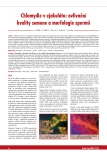Developmental defects in reproduction losses in the 1st trimester of pregnancy
Authors:
prof. RNDr. Ján Vojtaššák, CSc. 1; RNDr. Jana Malová, Ph.D. 1; MUDr. Ľudmila Demjénová 1; doc. MUDr. Miroslav Korbeľ, CSc. 2; MUDr. Peter Martanovič 3
Authors‘ workplace:
Ústav lekárskej biológie a genetiky Lekárskej fakulty UK v Bratislave
1; I. gynekologicko-pôrodnícka klinika Lekárskej fakulty UK v Bratislave
2; Ústav patologickej anatómie Lekárskej fakulty UK v Bratislave
3
Published in:
Prakt Gyn 2005; 9(2): 15-18
Overview
Early reproduction losses represent a part of prenatal selection system, which provides elimination of individuals with disturbed embryonal development. 1 829 spontaneous abortion of the 1st trimester of pregnancy from the region of Bratislava were cytogenetically and morphologically analyzed in the presented study. Severe disturbance of embryogenesis, almost in a half (45%) of informative analyzed cases were detected. At further 14% of cases milder development defects were detected and they could be considered the equivalent of inborn developmental defects. High frequency of chromosomal aberrations, predominantly trisomies, which represents a new gametic mutations, were detected. Information regarding the cause of the reproduction loss may increase the probability of successful termination of the next pregnancy.
Key words:
early reproduction losses — disturbance of embryogenesis — inborn developmental defects — chromosomal aberrations
Sources
1. Creasy MR, Crolla JA, Alberman ED. A cytogenetic study of human spontaneous abortions using banding techniques. Hum Genet 1976; 31(2): 177-196.
2. Carr DH, Gedeon MM. Q-banding of chromosomes in human spontaneous abortions. Can J Genet Cytol. 1978; 20(3): 415-425.
3. Boue A, Boue J. Chromosomal abnormalities associated with fetal malformation. In: Schrimgeout J (eds). Towards the prevention of Fetal Malaformation. Edinburgh: Edinburgh Univ Press 1978.
4. Hassold T, Chen N, Funkhouser J, Jooss T, Manuel B, Matsuura J, Matsuyama A, Wilson C, Yamane JA, Jacobs PA. A cytogenetic study of 1000 spontaneous abortions. Ann Hum Genet 1980; 44(2): 151-178.
5. Lakshmi KV, Satyanarayana M, Prabahker S and Sarvani R. Chromosomal Analysis in Recurrent Spontaneous Aborters. Ind J Hum Genet 2002; 8(2): 66-68.
6. O'Rahilly R, Muller F. Human Embryology & Teratology. 3rd ed. New York: Wiley-Liss 2001.
7. Mikamo K. Anatomic and chromosomal anomalies in spontaneous abortion. Possible correlation with overripeness of oocytes. Am J Obstet Gynecol 1970; 106(2): 243-254.
8. Kajii T, Ferrier A, Niikawa N, Takahara H, Ohama K, Avirachan S. Anatomic and chromosomal anomalies in 639 spontaneous abortuses. Hum Genet 1980; 55(1): 87-98.
9. Byrne J, Warburton D, Kline J et al. Morphology of early fetal deaths and their chromosomal characteristics. Teratology 1985; 32: 297-315.
10. Moore KL, Persaud TV, Chabner DEB. Developing Human: Clinically Oriented Embryology. 7th ed. Philadelphia: WB Sauders 2003.
11. Böhmer D. Analýza výskytu vrodených vývojových chýb u živonarodených novorodencov v Slovenskej republike. Gynekológia pre prax 2004; 1: 34-36.
12. Fujikura T, Froelich LA, Driscoll SG. A simplified anatomic classification of abortions. Am J Obstet Gynecol 1966; 95(7): 902-905.
13. Fantel AG, Shepard TH, Vadheim-Roth C et al. Embryonic and fetal phenotypes: prevalence and other associated factors in a large study of spontaneous abortions. In: Porter SH, Hook EB. Human embryonic and fetal death. New York: NY Acad Press 1980: 71-87.
14. Streeter GL. Developmental horizons in human embryos. Embryology Reprint II. Washington: Carnegie Inst 1951.
15. Dejmek J, Vojtaššák J, Malová J. Cytogenetic analysis of 1508 spontaneous abortions originating from south Slovakia. Eur J Obstet Reprod Biol 1992; 46: 129-136.
16. Bullerdiek J, Barnitzke S, Schloot W. A rapid and simple sandwich - method used for chromosome analysis from small fetal and adult biopsy specimens. Clin Genet 1979; 16: 433-437.
17. Lucket WP. The developmental of primordial and definitive amniotic cavities in early rhesus monkey and human embryos. Am J Anat 1975; 144: 149-167.
18. Vojtaššák J, Demjénová L, Ďuríková M, Danihel Ľ, Böhmer D, Korbeľ M. Anembryomola – charakteristika, výskyt, chromozómová analýza. Slovenská Gynekológia a pôrodníctvo 1996; 3(2): 50-54.
19. Philipp T, Philipp K, Reiner A, Beer F, Kalousek DK. Embryoscopic and cytogenetic analysis of 233 missed abortions: factors involved in the pathogenesis of developmental defects of early failed pregnancies. Hum Reprod 2003; 18(8): 1724-1732.
20. Philipp T, Kalousek D. Generalized abnormal embryonic development in missed abortion: embryoscopic and cytogenetic findings. Am J Med Genet 2002; 111: 43-47.
21. Guyer B, Hoyert DL, Martin JA, Ventura SJ, MacDorman MF, Strobino DM. Annual Summary of Vital Statistics – 1998. Pediatrics 1999; 104 (6): 1229-1246.
22. Tolarová M, Červenka J. Classification and birth prevalence of orofacial clefts. Am J Med Genet 1998; 13: 126-137.
23. Canki N, Warburton D, Byrne J. Morphological characteristics of monosomy X in spontaneous abortions. Ann Genet 1988; 31(1): 4-13.
24. Calzolari E, Bianchi F, Dolk H, Milan M. EUROCAT Working group: Omphalocele and gastroschizis in Europe: a survey of 3 million birth 1980–1990. Am J Med Genet 1995; 58: 187-194.
25. National Center for Heath Statistics. Monitoring the Nations Health. http://www.cdc.gov/nchs
26. Ford JH, Wilkin HZ, Thomas P, McCarthy C. A 13-year cytogenetic study of spontaneous abortion: clinical applications of testing. Aust N Z J Obstet Gynaecol 1996; 36(3): 314-318.
27. Wolf GC, Horger EO. Indication for examination of spontaneous abortion specimens: a reassessment. Am J Obstet Gynecol 1995; 173(5): 1364-1368.
Labels
Paediatric gynaecology Gynaecology and obstetrics Reproduction medicineArticle was published in
Practical Gynecology

2005 Issue 2
Most read in this issue
- Chlamydias in ejaculate; the influence on the quality and morphology of sperms
- Developmental defects in reproduction losses in the 1st trimester of pregnancy
- Minimal stimulation in the IVF/ICSI+ET programme
- Controversions in perimenopause and postmenopause
